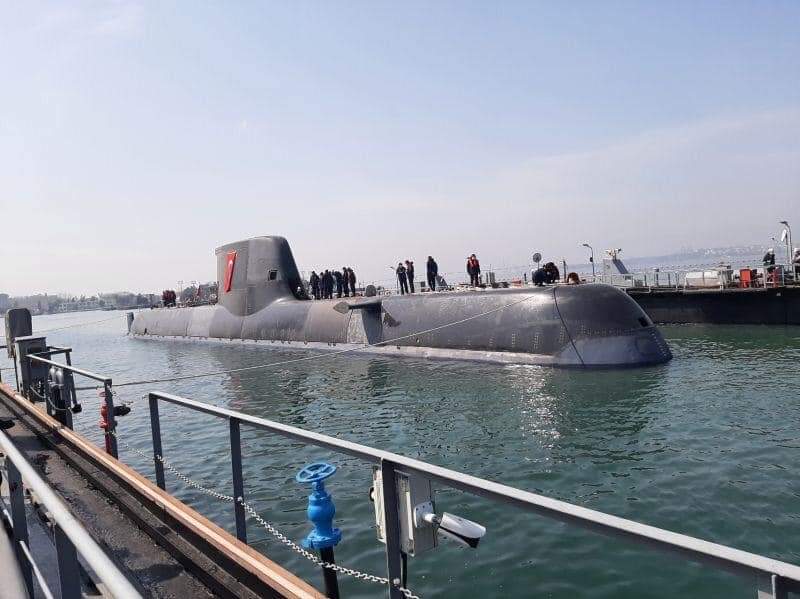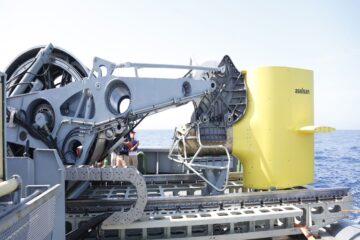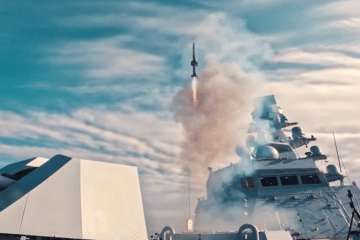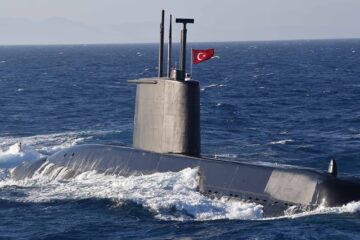The lead boat of Turkiye’s Reis-class submarine project, the Piri Reis, was observed at the Sea of Marmara by the local spotters on December 06, 2022. A tug and an S-70B accompanied the submarine during the tests.
Turkish officials didn’t release a statement about the commencement of the sea trials. Naval News confirmed that the submarine has started the sea trials, which are the last tests before the delivery.
As part of the project, the first submarine, the Piri Reis, which is being built at the Golcuk Naval Shipyard, was launched in 2019, floated in the water in March 2021. The second submarine Hizir Reis, which was dry-docked on 24 May 2022, is scheduled to be commissioned in 2023. From this year onward, one submarine will be commissioned every year, and 6 Reis-class submarines will be delivered to the Turkish Navy by 2027.

The initial delivery schedule of the submarines is given below;
- TCG Piri Reis – 2022
- TCG Hizir Reis – 2023
- TCG Murat Reis – 2024
- TCG Aydin Reis – 2025
- TCG Seydi Ali Reis – 2026
- TCG Selman Reis – 2027
It seems like Piri Reis, which will be the first Air Independent Propulsion capable submarine of the Turkish Navy, may enter the service in the first half of 2023. The Turkish Defense Agency (SSB) stated in the 2021 milestones that the first Reis-class submarine would be commissioned for the Turkish Navy in 2022. However, the commissioning of Pirireis was not included in the SSB’s video announcing the Turkish defense milestones for 2022.
The contract signed in July 2009 between the Presidency of the Turkish Defense Industries (SSB) and Thyssen Krupp Marine Systems is to build 6 submarines with an air-independent propulsion (AIP) system and place them in the service of the Turkish Naval Forces.
Importance of the project
The Reis-class submarine project is crucial for the Turkish Navy. These submarines will enhance the submarine fleet’s strength in surrounding seas by featuring AIP capability. The Turkish Navy has a 12-piece submarine fleet consisting of four Ay-class (Type 209/1200), four Preveze-class (Type 209T/1400), and four Gür-class (Type 209T2/1400), all conventionally-powered (diesel-electric) attack submarines. By 2027, Turkey will be operating six Reis-class AIP submarines.
The Reis-class will benefit not only the Turkish Navy but also Turkey’s defense technological and industrial base. The know-how and experience gained from the Reis-class submarine project will be a strong reference for indigenous submarines intended to be built under the National Submarine (MİLDEN) project, which is currently at the design phase and expected to be built in the 2030s. There are many Turkish sub-contractors, including ASELSAN, HAVELSAN, MilSOFT, Defense Technologies Engineering and Trade Inc. (STM), Koç Information and Defense, Scientific and Technological Research Council of Turkey (TÜBİTAK), and AYESAŞ working on Reis-class submarines’ sub-systems such as navigation and data management system, data link, torpedo countermeasure system, etc.
About Reis-class submarines

The Reis-class submarines feature a single-hull, one-compartment design and an air-independent propulsion system on the proven Howaldswerke-Deutsche Werft (HDW) fuel cell. The submarines have a length of 68.35 meters, an outer diameter of 6.3 meters, a displacement of 1,850 tons, and a capacity of 40 personnel.
ThyssenKrupp Marine Systems have been building the Reis-class submarines (known initially as Type 214 TN) in Turkey’s Golcuk Shipyard. The AIP system uses fuel cell technology, PEM Fuel Cell (2x120kw), and high-capacity batteries (2×324 units). This provides the submarine with the ability to conduct long-endurance deployments without snorkeling.
The boats will deploy heavyweight torpedoes (MK48 Mod 6AT and DM2A4), anti-ship missiles (Sub-Harpoon), and mines. Indigenous heavyweight torpedo Akya and anti-ship missile Atmaca are expected to be fitted to the next submarines of the project. The Reis-class submarine will be able to undertake missions such as littoral water operations to ocean-going patrols, including anti-surface and anti-submarine operations, ISR tasks, and special forces operations. This is mainly thanks to their increased diving depths and their modular weapon and sensor mix.






